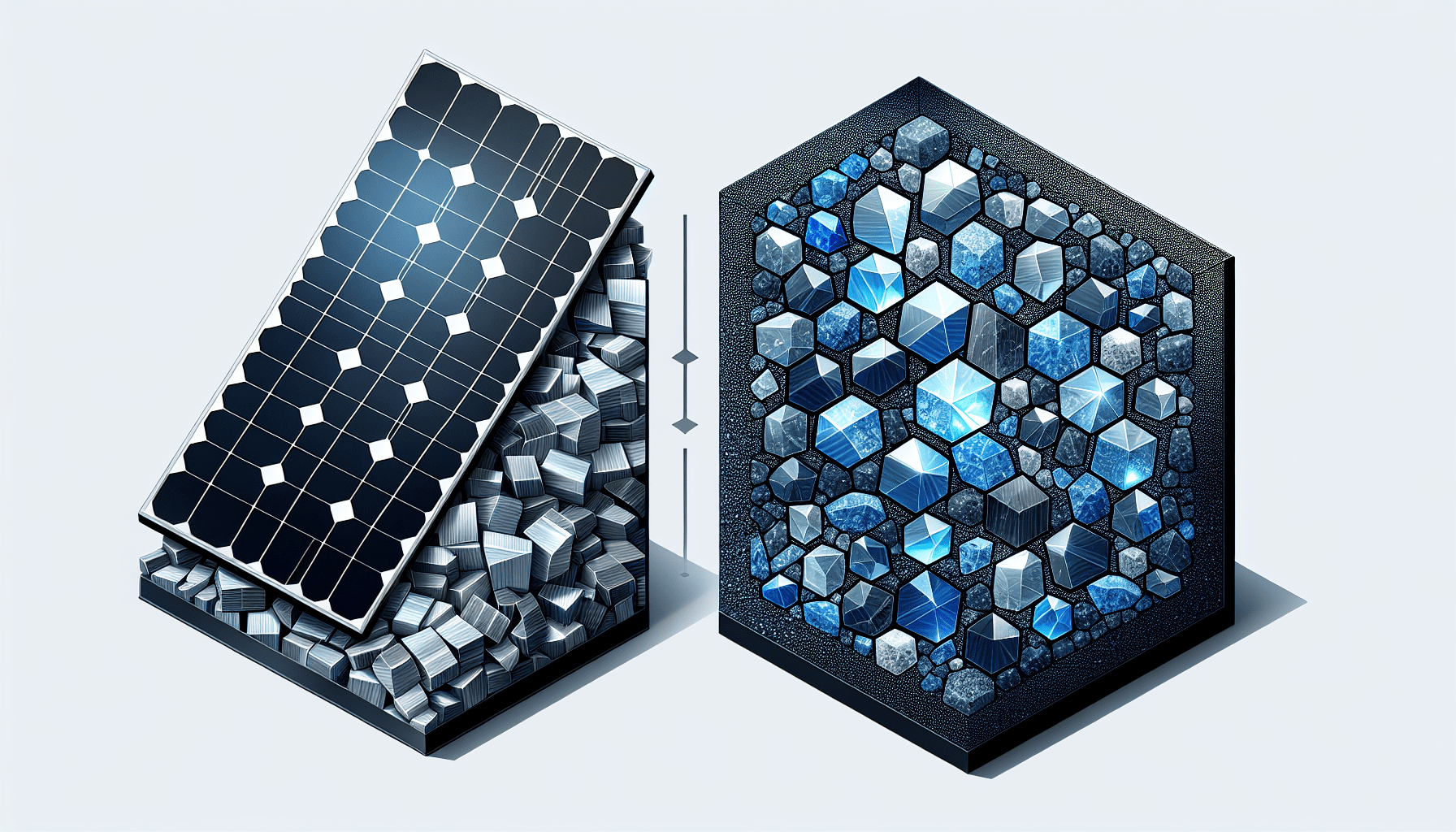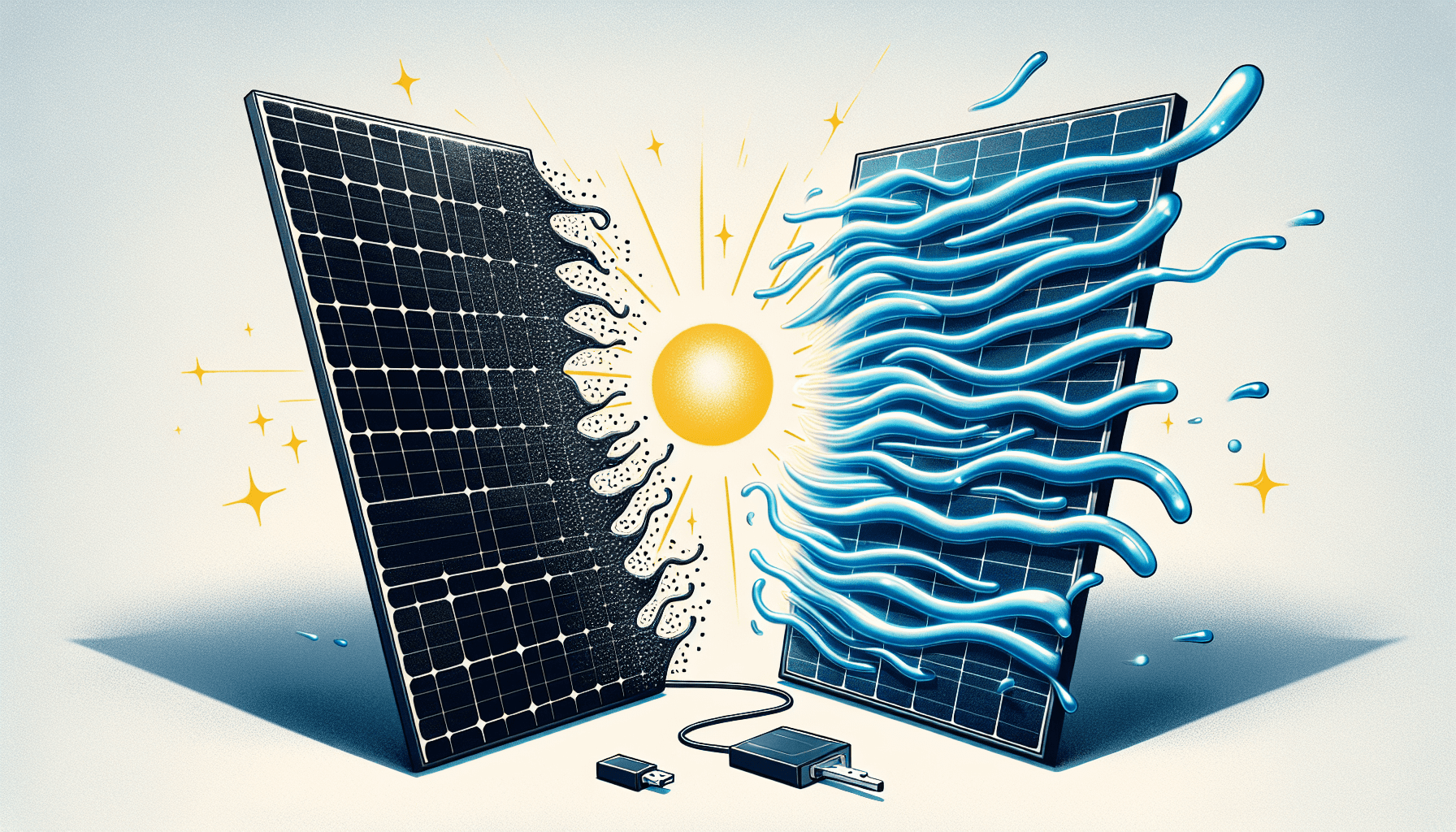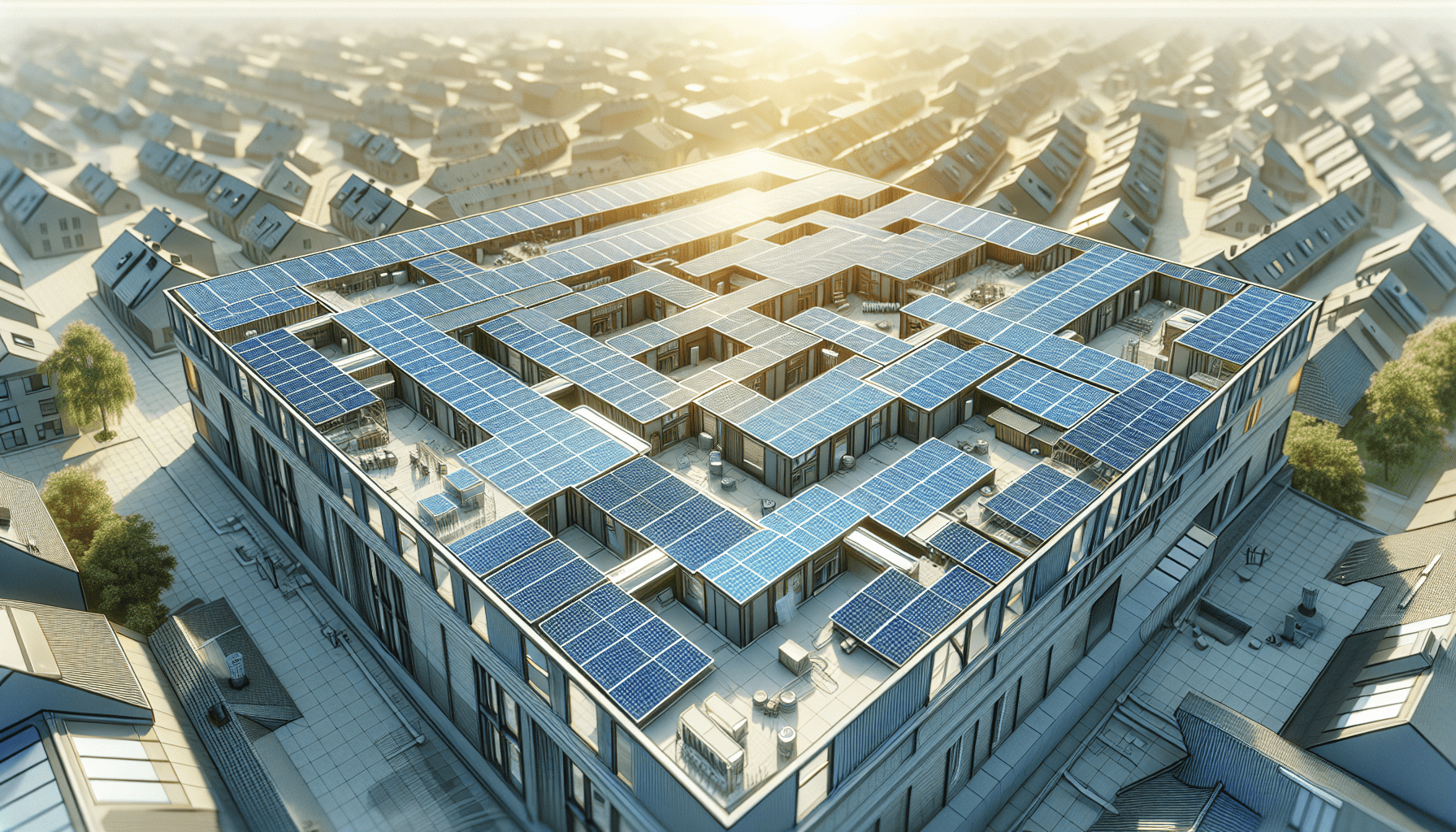When considering monocrystalline vs polycrystalline solar panels, essential factors such as efficiency, cost, and durability come into play. This article offers a straightforward comparison to streamline your decision-making process for a solar-powered home.
Key Takeaways
- Monocrystalline solar panels are made from single, pure silicon crystals and are more efficient (17% to 22%), whereas polycrystalline panels are made from multiple silicon crystals and are less efficient (13% to 17%).
- While monocrystalline panels offer higher efficiency and lower temperature coefficients, making them more suitable for hot climates and limited spaces, they cost more upfront than polycrystalline panels.
- Both panel types have a lifespan of 25-30 years or more, and new solar technologies, battery systems, and EV charging integration are advancing the solar industry and personal energy independence.
Understanding Solar Panel Types: Monocrystalline and Polycrystalline

Solar panels come in various types, but monocrystalline and polycrystalline panels are the most common. They both are made from silicon, a durable and abundant material, but the way this silicon is used differs in each type. This results in panels with different efficiencies, appearances, and costs.
We’ll examine the silicon source and aesthetics of these two types of panels.
The Silicon Source: From Pure to Mixed
The difference between monocrystalline and polycrystalline solar panels starts with how they’re made, which is the core of the “monocrystalline vs polycrystalline solar” debate. Monocrystalline panels are made from a single, pure silicon crystal that’s grown in a lab. This crystal is formed into a cylindrical shape, then cut into thin wafers and treated to optimize efficiency. These wafers are then used to create monocrystalline cells, which are assembled into the final panel. In contrast, polycrystalline solar cells are made from multiple silicon crystals, giving them a distinct appearance and slightly different performance characteristics.
On the other hand, polycrystalline panels are made by melting multiple silicon crystals together in their manufacturing process. This mixture is then molded into the shape of the panel. Thus, monocrystalline panels are made from a single silicon crystal, while polycrystalline panels consist of multiple silicon fragments fused together.
Color and Design: Aesthetic Differences
When it comes to aesthetics, monocrystalline and polycrystalline solar panels present different looks. Monocrystalline panels have a uniform black color that often blends seamlessly with most roofs. In contrast, polycrystalline panels have a distinctive blue hue. This difference in color, along with differences in cell shape, can affect how well the panels integrate with your property’s appearance. Therefore, when choosing between these two types of panels, aesthetics can play a significant role.
Efficiency and Performance: A Comparative Analysis

When comparing monocrystalline and polycrystalline solar panels, efficiency and performance are key factors. Efficiency refers to how well the panels convert sunlight into electricity, and performance relates to how they function under different conditions, such as high temperatures.
Monocrystalline panels are generally more efficient and perform better in warm weather compared to polycrystalline panels. However, the lower upfront cost of polycrystalline panels could make them a more attractive option for some homeowners.
Harnessing Sunlight: Conversion Rates
Compared to polycrystalline panels, monocrystalline solar panels are more efficient in terms of solar panel efficiency. They boast an efficiency range of 17% to 22%, while polycrystalline panels usually fall within a 13% to 17% efficiency range. This is because monocrystalline panels are made from a single silicon crystal, which provides a simpler path for electrons to flow, resulting in more efficient energy production.
However, their higher efficiency often means monocrystalline panels require less roof space compared to polycrystalline panels to generate the same power output.
Weathering the Heat: Temperature Coefficients
Another performance factor to consider is the panel’s temperature coefficient. This measures how much the efficiency of solar panels decreases as the temperature rises. Monocrystalline solar panels have a lower temperature coefficient, meaning they perform better in heat, while polycrystalline panels tend to have higher temperature coefficients, reducing their performance in hot conditions.
Therefore, if you live in a hot climate, monocrystalline panels might be a better choice.
Costs and Longevity: Balancing the Investment
While efficiency and aesthetics are essential, the costs and longevity of the panels play a crucial role in your decision. Both monocrystalline and polycrystalline solar panels have a lifespan of 25 to 30 years or more, but their costs are different.
Monocrystalline panels are more expensive upfront, but their higher efficiency can lead to more significant savings over time. On the other hand, polycrystalline panels are less expensive to produce and, therefore, cheaper to buy, but they may not last as long or provide as much energy.
Price Points: Upfront and Over Time
Monocrystalline solar panels typically cost between $1 to $1.50 per watt, making them more expensive than polycrystalline panels at the point of purchase. Yet, there’s a 30% federal solar tax credit available to help offset these costs. Also, because monocrystalline panels are more efficient, you might need fewer of them, which could lead to long-term savings.
Thus, it’s crucial to plan your finances carefully when considering solar panel installations.
Durability Over Decades: Warranties and Lifespans
Solar manufacturers typically provide a 25-year power production warranty for longevity, while some brands have begun offering 30-year coverage. This demonstrates the increasing confidence in the long-term performance and durability of solar panels. Both monocrystalline and polycrystalline solar panels can efficiently produce electricity for 25 years or more, with monocrystalline panels often reaching a lifespan of 30–40 years with optimal care. However, polycrystalline panels are projected to have a slightly shorter lifespan due to their lower tolerance for heat.
Space Considerations: Roof Real Estate and Panel Placement

The space available for solar panels on your property is another crucial factor to consider. The type and number of panels you can install significantly depend on the amount of available roof space. For example, if you have a smaller roof, you might prefer monocrystalline panels due to their higher efficiency, meaning you’ll need fewer panels to meet your energy needs.
However, if space is not an issue, polycrystalline panels, which utilize polycrystalline cells, could be a cost-effective choice.
Maximizing Limited Areas: Efficiency vs. Quantity
If your roof space is limited, you’ll want to maximize your energy generation. Monocrystalline panels are more efficient than their polycrystalline counterparts, meaning they can generate more power in a smaller area. So, if you’re dealing with a limited area, monocrystalline panels could be your optimal choice for energy production.
Custom Installations: Artisan Electric’s Approach
Selecting a trustworthy solar installer holds equal importance to choosing the right type of panels. Artisan Electric is known for its full-service turn-key approach to solar panel system installation, offering comprehensive service from:
- Initial consultation
- System design and engineering
- Permitting and interconnection
- Installation and commissioning
- System activation and monitoring
Their customized installations focus on strategic optimization of solar system efficiency, considering the unique limitations of the available space.
This personalized approach ensures that your solar system aligns with your individual budget and specific energy requirements.
Beyond the Basics: Additional Solar Technologies
Even though monocrystalline and polycrystalline panels are the most prevalent, other solar panel options also exist. Some of these options include:
- Thin-film panels
- Concentrated solar power (CSP) systems
- Building-integrated photovoltaics (BIPV)
- Organic solar cells
- Perovskite solar cells
Emerging solar technologies, such as thin-film panels and other cutting-edge innovations, are pushing the boundaries of what’s possible in solar energy generation.
Thin Film Panels: Flexibility and Use Cases
Thin-film solar panels are made from thin layers of photovoltaic material deposited on a substrate such as glass, plastic, or metal. These panels are more flexible than traditional solar panels, opening up opportunities for integration into various parts of a building, such as windows, walls, and even blinds.
While thin-film technology is still evolving, it offers promising potential for the future of solar energy.
Cutting-edge Innovations: PERC and Bifacial Technologies
Continuous research and development in the solar energy sector are paving the way for innovative breakthroughs with the potential to transform the industry. For example, the National Renewable Energy Laboratory (NREL) is researching high-efficiency solar cell technologies that could significantly enhance solar panel performance.
While these innovations are still in development, they offer a glimpse into the future of solar power.
Integrating Solar Solutions: Battery Systems and EV Charging
Apart from the solar panels, other methods are available to augment your renewable energy solution. Integrating your solar panels with a home battery system or an electric vehicle (EV) charging station can provide additional benefits, from energy independence to supporting sustainable transportation.
Energy Independence: Advantages of Home Battery Systems
A home battery system can:
- Store excess energy generated by your solar panels for use when the panels aren’t producing electricity, such as during a power outage or at night
- Offer significant financial benefits
- Reduce your reliance on the grid
- Extend the useful life of your battery system.
Hence, coupling a home battery system with your solar panels can boost your energy autonomy and resilience.
Sustainable Transportation: Solar-Powered EV Charging
If you own an electric vehicle (EV), integrating a solar-powered EV charging station into your home’s solar energy system can be a game-changer. Not only does this allow you to power your vehicle with clean, renewable energy, but it can also lead to significant long-term savings by reducing fuel costs and potentially offsetting charging expenses. Plus, various incentives and rebates are available for installing solar-powered EV charging stations, further reducing upfront costs.
Making Your Choice: Factors to Consider When Selecting Solar Panels
After delving into the multiple aspects of solar panels – their types, efficiency, costs, aesthetics, space considerations, and emerging technologies, now is the time to ponder on the factors that hold the most importance for you in selecting the appropriate panels. Whether you prioritize:
- aesthetics
- efficiency
- cost
- innovative technology
Your unique needs and preferences will guide your decision.
Personal Preference and Aesthetics
One factor that can significantly influence your choice of solar panels is your personal preference, especially concerning aesthetics. The sleek black design of monocrystalline panels offers a modern, streamlined look, while the distinctive blue hue of polycrystalline panels might better match your home’s design or your personal taste.
Ultimately, the choice depends on which look you prefer and how the panels fit into your home’s overall aesthetic.
Assessing Your Space and Solar Needs
The amount of space available for solar panels on your property is another key factor to consider. If you have a smaller roof, you might prefer monocrystalline panels due to their higher efficiency, which means you’ll need fewer of them to meet your energy needs.
Conversely, if space is not an issue, polycrystalline panels could be a cost-effective choice. It’s also worth considering the orientation and angle of your roof, as these factors can affect the panels’ exposure to the sun and, consequently, their energy production.
Financial Planning: Costs and Financing Options
Finally, considering the financial aspects of installing solar panels is of utmost importance. While monocrystalline panels tend to be more expensive upfront, they can lead to more significant long-term savings due to their higher efficiency. Various financing options are available to help you manage these costs, including personal loans, home equity loans, and federal tax credits.
By carefully planning your finances, you can find a solar solution that fits your budget and maximizes your return on investment.
Summary
To sum up, choosing the right solar panels for your home involves a careful evaluation of various factors, including the panels’ efficiency, cost, aesthetics, and the space available on your property. While monocrystalline panels are generally more efficient and aesthetically pleasing, they come with a higher upfront cost compared to polycrystalline panels. However, technological advancements are paving the way for more innovative and potentially more efficient solar solutions. Ultimately, the choice between monocrystalline and polycrystalline panels depends on your unique needs, preferences, and budget. With careful planning and consideration, you can harness the power of the sun to meet your energy needs in a sustainable and cost-effective way.
Frequently Asked Questions
What is the main difference between monocrystalline and polycrystalline solar panels?
The main difference between monocrystalline and polycrystalline solar panels is the silicon composition. Monocrystalline panels are made from a single silicon crystal, while polycrystalline panels consist of multiple silicon fragments fused together. This affects efficiency, cost, and aesthetics.
Are monocrystalline solar panels more efficient than polycrystalline panels?
Yes, monocrystalline solar panels are generally more efficient than polycrystalline panels, with a higher efficiency range of 17% to 22% compared to 13% to 17%.
How does the temperature coefficient affect the performance of solar panels?
The temperature coefficient affects the performance of solar panels by measuring how efficiency decreases as temperature rises. Monocrystalline panels perform better in heat with a lower coefficient, while polycrystalline panels have higher coefficients, reducing their performance in hot conditions.
What are some financing options for solar panel installations?
Consider personal loans, home equity loans, and federal tax credits as financing options for solar panel installations. They can help manage upfront costs and make solar energy more accessible.
What are some emerging solar technologies?
Some emerging solar technologies to look out for are thin-film panels, perovskites, quantum dots, thermochromic photovoltaic glass, and night solar. These options show great promise for the future of solar energy.
